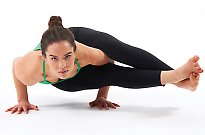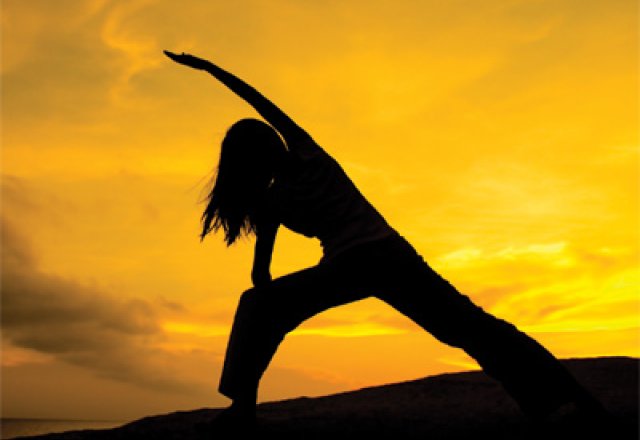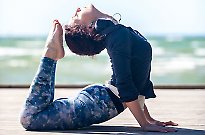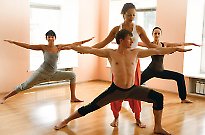
Moksha yoga
The power of holistic yoga

Accredited yoga teacher Emma Palmer talks about the power of a holistic yoga practice for health and wellbeing
When did you begin practising yoga?
My love of yoga first began when I started practising a variety of styles in 1998. I then decided to undertake a yoga teacher training course in 2001. From there, profound changes began within me and in my life. I made the decision to pursue this path full-time in 2004 and started Moksha Yoga in 2005 and The Moksha Academy of Yoga (RYS200) in 2010. Moksha literally started from an idea of starting out on my own, where I hired a room and began offering a couple of classes a week. Moksha has continued to grow organically ever since.
What physical, psychological and spiritual changes have you experienced since starting a regular yoga practice?
One of the reasons I started to practise yoga back in 1998 was that through extensive travelling, I had developed a prolapsed disc. I was seeing a lot of health practitioners and realised I needed something else to help me manage the injury, and that’s one of the reasons I started yoga. My current health care practitioners have acknowledged that had I not practised yoga since the onset of my injury, my spine degeneration would have been far greater than it is today.
My immune system has also improved dramatically; that’s a common benefit of practicing yoga. Yoga also helps support my endocrine, nervous and digestive system, but for me the real benefit has been the spinal support and strength to better manage my injury from 14 years ago as well as how yoga has contributed to who I am as a person.
Yoga has also helped me adapt to the changes of moving from London to Australia and managing the associated life challenges that came with that experience. For a lot of people, their yoga practice is the one thing that anchors them despite all the challenges they face. Yoga helps you move through the different processes of change and certainly for me, being able to create Moksha Yoga has allowed me to live a life with purpose. I’m following my own dreams and hopefully supporting and encouraging others to do the same. The reality is, the challenges will always be there; however it is how we manage those challenges through the practice of yoga that allows the true teachings to come alive.
Who has been the major influence in the way you teach and practise yoga?
There have been many different teachers I’ve come across on my travels over the years who have really influenced me, and certainly teachers who have incorporated the philosophical, spiritual and holistic health components of yoga with a Western, modern focus, and the realisation that we’re facing a lot of challenges in our daily lives have been inspirational to me. They have taught me that yoga helps us to sustain life’s challenges and constant changes rather than just being a physical activity. Yoga is a way of life and a way of being.
Every teacher has something significant to share and the teachers I have found along the way have always taught me what I needed to know at that time. For me, my path has recognised that rather than just have one lineage (one teacher, one style of yoga that you stick with for life), I’ve found that different teachers have come from all different styles and lineages and I think there’s real value in that openness and recognising that they each have their place. Yoga isn’t just about the physical postures; it’s the meditation, reading of philosophy, the application of a yogic life into our daily living and the immense healing that can occur on a cellular level that makes yoga so powerful.
Why did you decide to start a yoga teacher training school?
Starting the Moksha Academy of Yoga was a very organic process and a natural next step to take. I had been lecturing as a yoga teacher trainer for about six years and it was around 2010 that I recognised there was always the same consistent feedback with each graduate: teacher trainees had a strong desire to be able to experience hands-on practical teaching with students presenting with different injuries and diagnoses that called for a thorough, holistic understanding of anatomy and physiology. In reality, I knew that is what they would be facing when they started to teach post-graduation. As a result of this, a students’ practice needed to be considerably modified rather than a one-size-fits-all approach, and teacher trainees needed to have this experience with supervision while they were studying and being mentored.
I was able to draw my anatomy and physiology training from the science degree I had begun in 2004 and through my teaching experience. I felt it was really important as a yoga teacher to have that integrity in sharing in a particular posture, a strong understanding of the body’s functions and to understand which postures could be beneficial and which might potentially exacerbate an injury or condition.
It wasn’t until 2010 that I made the decision to expand Moksha Yoga to offer teacher training. Being from London originally, I wanted to look at what the world was offering in terms of teacher training. I felt it was really important for teachers to gain international accreditation and Yoga Alliance is the accredited provider we chose. In September 2010, the Moksha Academy of Yoga (RYS200) was born and we opened the doors for our first intake.
You are an E-RYT-500 accredited yoga teacher. What does this mean?
E-RYT-500 is a title provided by Yoga Alliance. Literally translated it means that Yoga Alliance have accredited me as an experienced registered yoga teacher (ERYT), having undertaken a minimum of 500 hours of yoga teacher training. Yoga Alliance provides this level of accreditation for teachers who have taught a minimum of 2000 hours. Yoga Alliance acknowledges that this also provides students with an assurance that their training is led by someone who has dedicated sufficient hours to yoga study and practice consistently over a period of time.
Your school, the Moksha Academy of Yoga, has Yoga Alliance accreditation. What does this signify?
Yoga Alliance accreditation means that students who successfully complete our RYT200 course are recognised to teach within Australia and internationally. Being Yoga Alliance accredited has really supported us and our teacher trainees because it means they can travel anywhere in the world and have that accreditation.
We have created an accredited course designed for teachers to have a strong understanding of a Western body, where we’re more likely to see students presenting with disease and injury, and where the capabilities are so different to the practitioners of India thousands of years ago. Not only did we want to share the spiritual component of the traditional texts of yoga, but recognise this Western component and that modern living needed to be incorporated into our classes. Our course is designed for the dedicated yoga student who has a passion for the teachings and practices of yoga. There is no doubt that our course is personally, mentally and physically challenging however it is also incredibly rewarding and provides a strong foundation for the teachings of yoga to continue to grow.
To be able to do what you love and have that as a career path is such an honour and a privilege; to provide the space for others who want to do the same, who want to incorporate their love of yoga into their own lives while making a difference to others as a career path, is incredibly rewarding for all the lecturers and teachers at Moksha. To be a yoga teacher full time is an opportunity that is far more available now than when I did my training back in 2001.
Our goal is to provide a consistently high academic standard of learning and experience within the field of yoga studies, so that yoga teachers of the modern age are able to contribute to the health and wellbeing of all students and teachers alike.
What is the teaching philosophy at Moksha Yoga?
Our philosophy is that yoga should be accessible to everybody, and we provide classes that fit into everybody’s needs, whether it’s a strong practice, gentle practice, children’s yoga, pre-natal yoga, mums and bubs yoga, yoga as a therapy or an intensive three-hour class!
We provide a comfortable, welcoming space where everybody has the opportunity to practise. At Moksha it’s about going back to the traditional roots of healing, where students choose the practice and variations that are right for them. Just like our daily lives, our practice is always changing and is affected by our emotions and our stress levels. We believe that yoga is a life practice.
Our philosophy is that yoga reveals the strengths that are already present within us. The healing that takes place at a cellular level to optimise health gives us the capacity to live more freely, with a greater sense of vitality. We recognise yoga is a multi-faceted approach and that students are there to nurture their physical, mental, emotional and spiritual bodies and that’s really what yoga is all about. A consistent practice helps our students manage their day-to-day stress and have somewhere to come and feel supported and be centred while on their mats.
How can yoga be used in support of a detox program?
A strong, heated asana practice can be a beneficial adjunct to a monitored detox program, as a strong vinyasa practice heats the blood and helps optimise liver function. The liver is one of our major organs for detox but it also needs to be supported by the kidneys and lungs. Detoxification also occurs through the lymphatic system, where our major wastes are removed from the body and also the integumentary system, which is the skin. Sweating helps to cleanse the body from the inside out. Postures like spine twists for example are excellent for the digestive organs and a wonderful way to cleanse internally and from the inside out.
Moksha Yoga focuses on the vinyasa style of yoga. What is the emphasis of this style of yoga and what are some of the associated health and wellbeing benefits?
The vinyasa style of yoga resonates with me because it doesn’t just challenge me physically, but mentally and emotionally as well. Yoga is the union of all of the qualities of being. It’s a flowing form, moving from one posture to the next with synchronicity of the breath.
Browse more health advice or join the debate on our Facebook page.

